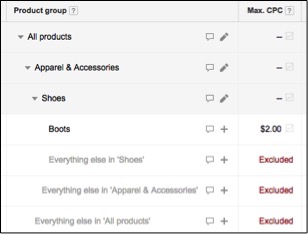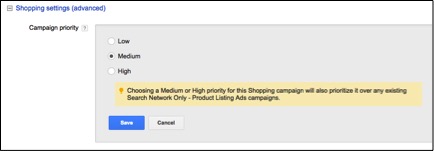Don’t Let Google Shopping Campaigns Trip You Up

It’s been just about a year since Google officially replaced Product Listing Ads (PLAs) with the new and updated Shopping campaigns. Shopping campaigns provide everything an online shop could want: prime real estate on search pages, attention grabbing images, and hyper relevance to searcher intent.
Yet, for all their great aspects in promoting products to would be buyers, they can be a headache to manage if you don’t wrap your head around some of their quirks. The last thing you want is a potential customer to miss out on all your great products.
This post details a couple of things to keep in mind when building and managing your Shopping campaigns.
We Aren’t In Keyword Land Anymore
One aspect of Shopping campaigns that gets people into trouble is they don’t have keywords in the same way traditional search campaigns do. Instead of adding keywords in order to target search queries, Shopping campaigns by default are targeting everything in your shopping feed that matches a search query. For example, if you bid on the keyword “oval coffee tables” you can create a text ad going to the page you desire. In a Shopping campaign, Google will show a product that it feels best matches that query (even if you sell thirty oval coffee tables).
A good way to think about it is to see traditional search as opt-in targeting (adding keywords) and Shopping campaigns as opt-out targeting (excluding sections of your feed). Seems simple on the surface, but failing to understand this concept can create all sorts of headaches.
So what’s a savvy paid search marketer to do? Enter the power of exclusions. When creating different Shopping campaigns and ad groups you can focus on promoting various parts of your product feed (a specific brand or product for example) or just default to the entire feed.
Say you really want to promote boots during the winter months because it’s a huge seller for your company. All you have currently is a single Shopping campaign with no exclusions and a low bid that’s generically targeting your product feed to any relevant search queries.
To promote boots you would need to do one of two things: create a separate product group in the existing campaign or create a new campaign (particularly if budgets are a concern). Then you would choose the product category you want to bid up and exclude the rest of the feed. You can see this in action below.

Now you’ll be promoting the boots category with a $2 bid while excluding everything else in the feed that you want to get picked up by a lower bid in your general products campaign. In this example we excluded everything in each parent category (apparel & accessories, shoes) to be safe, but simply excluding ‘All Products’ should do the trick just fine.
Keep a Watch on Priority Settings
Time and time again I’ve seen Shopping campaigns shoot themselves in the foot by not paying attention to the role of priority settings in their campaigns. Some are set to high, some to low, and some to medium in an arbitrary way that causes all sorts of issues. Bids end up overriding other bids in ways that are completely unintended and potential sales volume is lost in the process.
What can be done?
Get a handle on those priority settings.

The key thing to remember is that if one campaign is tagged high and the other low priority, the high priority will always override the low one no matter what the bids are if they can both show for the same search query. If the campaigns are set to the same priority level, then bid becomes the determining factor.
Using the example from the above section, we have two campaigns: a general Shopping campaign focused on your entire feed and a campaign focused on bidding up the product category of boots for the winter season.
Let’s look at two scenarios.
In the first scenario your general Shopping campaign has a blanket bid of $1 and a priority set to high. The new campaign focused on the boots category has a bid of $2 and a priority of low.
In the second your general shopping campaign has the same bid of $1, but its priority is set to low. Your campaign dedicated to bidding up boots has the same $2 bid, but its priority is also set to low.
What happens in each?
In the first case your general Shopping campaign will be doing the bidding on all of your products including the boots category because the high priority is overriding everything else. So that $2 bid you hoped would get you increased sales is now a $1 bid and potentially missed sales volume.
In the second case both priorities are set to low so no campaign is automatically overriding the other. It all comes down to bids and in this case the boots focused Shopping campaign wins out with a higher $2 bid.
So when does it makes sense to use priority? The real benefit of priority settings comes in managing general Shopping versus focused Shopping campaigns like the boot example above. For your campaigns with a particular focus (such as top sellers) and higher bids, a higher priority makes certain those bids are recognized. Then if a search query doesn’t match any of those focused campaigns it can fall back to a bid in the low priority general campaign. Either way your campaigns, bids, and ads are working the way you intended.
Go Forth and Sell Product
Take these tips and do a 15 minute check on your account to make sure your priority settings and campaign exclusions are up to par. It could just save you time, money, and lots of headaches.



